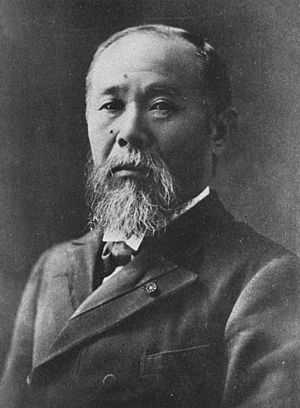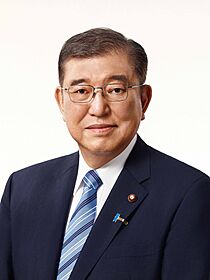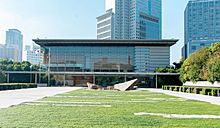Prime Minister of Japan facts for kids
Quick facts for kids Prime Minister of Japan |
|
|---|---|

Standard of the Prime Minister of Japan
|
|

Emblem of the Prime Minister of Japan
|
|
| Executive branch of the Japanese government Office of the Prime Minister |
|
| Style | Naikaku sōridaijin (formal) His Excellency (formal and diplomatic) Shushō (informal and during Party debates) Sōri (informal) |
| Member of | Cabinet National Security Council National Diet |
| Residence | Naikaku Sōri Daijin Kantei |
| Seat | Tokyo |
| Nominator | National Diet |
| Appointer | Emperor |
| Term length | No fixed term length,
renewable indefinitely.
|
| Constituting instrument | Constitution of Japan |
| Precursor | Daijō-daijin of Japan |
| Formation | 22 December 1885 |
| First holder | Itō Hirobumi |
| Deputy | Deputy Prime Minister |
| Salary | ¥40,490,000/ USD$ 257,597 annually |
The Prime Minister of Japan is the leader of Japan's government. This important role means they are in charge of the Cabinet of Japan, which is like a team of ministers who help run the country. The Prime Minister also leads Japan's military, known as the Japan Self-Defense Forces.
The National Diet (Japan's parliament) chooses the Prime Minister from its members. Usually, this person is from the House of Representatives. After the Diet chooses, the Emperor formally appoints them. To stay in office, the Prime Minister must keep the support of the House of Representatives. The Prime Minister lives and works at the Naikaku Sōri Daijin Kantei, which is their official residence and office in Tokyo.
Many people have served as Prime Minister of Japan. The first was Itō Hirobumi, who started on December 22, 1885. The person who served the longest was Shinzo Abe, for over eight years. The shortest-serving Prime Minister was Prince Naruhiko Higashikuni, who served for only 54 days. The current Prime Minister is Shigeru Ishiba, who took office on October 1, 2024. He became Prime Minister after the 2024 Liberal Democratic Party (Japan) presidential election.
Contents
What the Prime Minister Is Called
In Japan, the Prime Minister has a few different names depending on the situation. The official title is Naikaku Sōri-Daijin (内閣総理大臣), which means "Prime Minister of the Cabinet."
Shorter Names
People often use shorter versions of the title. These include Sōri-Daijin (総理大臣), Sōri (総理), or Shushō (首相). These shorter names are used in everyday talk or during political discussions. In English, the official title is simply "Prime Minister."
History of the Role

Before Japan had its modern constitution, the country's government worked differently. For a long time, Japan used a system called ritsuryō, which was inspired by ancient China. This system had a detailed government structure, but the real power often belonged to powerful families or military leaders called shōgun.
The role of Prime Minister as we know it today began in 1885. Before that, the highest government position was the Daijō-daijin (Chancellor of the Realm). This office was replaced when Itō Hirobumi became the first "Minister President of State" in 1885. The role became what it is today with the adoption of the Constitution of Japan in 1947.
So far, 65 different people have served as Prime Minister. Shinzo Abe holds the record for the longest time in office. He served two separate terms, totaling over eight years. The shortest term was by Prince Naruhiko Higashikuni, who served for just 54 days in 1945.
How the Prime Minister Is Chosen
The Prime Minister is chosen by both houses of the National Diet. Both houses vote, and if they pick different people, they try to agree on one person. If they still can't agree, the choice made by the House of Representatives becomes the final decision. This means the House of Representatives has a lot of power in choosing the Prime Minister.
After being chosen by the Diet, the person is officially appointed by the Emperor at the Tokyo Imperial Palace. Because the Prime Minister needs the Diet's support to stay in power, they are almost always the leader of the main political party in the House of Representatives. Sometimes, they might be the leader of a party that is part of a ruling group of parties.
Who Can Be Prime Minister
To become Prime Minister of Japan, a person must meet a few requirements:
- They must be a member of either the House of Representatives or the House of Councillors in the National Diet. This means they must be at least 25 years old and a Japanese citizen.
- They must be a civilian. This means they cannot be a serving member of the Japan Self-Defense Forces. However, former military members can become Prime Minister.
What the Prime Minister Does
The Prime Minister has many important jobs and responsibilities:
Leading the Government
- They oversee and guide all parts of the government's executive branch.
- They propose new laws to the Diet on behalf of the Cabinet.
- They sign laws and government orders, along with other Cabinet members.
- They choose all the Cabinet ministers and can remove them at any time.
- They can allow legal action to be taken against Cabinet ministers if needed.
Reporting to the Diet
- They must report to the Diet about Japan's affairs, both inside the country and with other nations.
- They must answer questions and explain things to the Diet when asked.
- They can suggest to the Emperor that the House of Representatives be dissolved, which means new elections would be held.
Other Important Roles
- The Prime Minister leads all meetings of the Cabinet.
- They are the Commander-in-chief of the Japan Self-Defense Forces, meaning they are the top leader of the military.
- They can overrule a court order against a government action if there's a good reason.
Unlike leaders in many other countries with a monarch, the Prime Minister of Japan is truly in charge of the government. The Constitution of Japan clearly states that the Cabinet, led by the Prime Minister, holds the executive power. This gives the Prime Minister a very strong position.
Symbols of the Office
Official Office and Home
The Prime Minister's main office in Japan is called the Naikaku Sōri Daijin Kantei. It is located close to the Diet building. The current Kantei building opened in 2002. The older Kantei building, used from 1929 to 2002, is now the official residence, called the Kōtei. The Kōtei is connected to the Kantei by a walkway.
Travel for the Prime Minister
The Prime Minister of Japan travels in special vehicles. For car travel, they use a Toyota Century. Before 2019, a Lexus LS 600h L was used, and it is still available as a backup car.
For air travel, the Japanese government has two Boeing 777 airplanes. These planes are also used by the Emperor, the imperial family, and other high-ranking officials. These aircraft are known as Japanese Air Force One and Japanese Air Force Two when on official missions. They always fly together, with one as the main plane and the other as a backup.
Images for kids
See also
 In Spanish: Primer ministro de Japón para niños
In Spanish: Primer ministro de Japón para niños

















